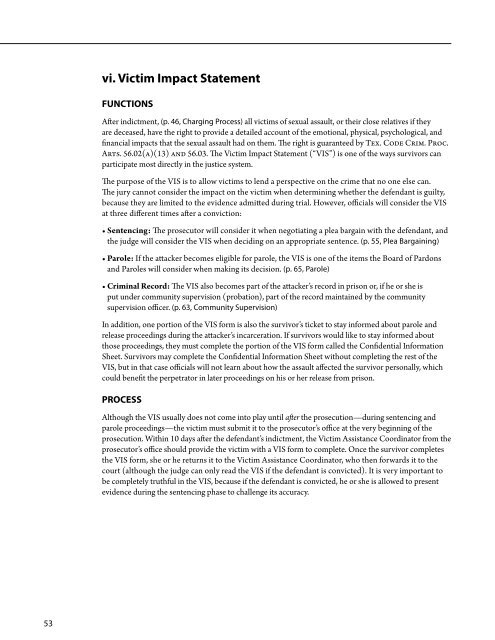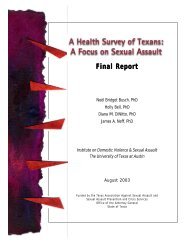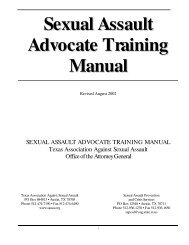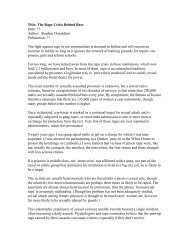Sexual aSSault LEGAL ADVOCACY MANUAL - Texas Association ...
Sexual aSSault LEGAL ADVOCACY MANUAL - Texas Association ...
Sexual aSSault LEGAL ADVOCACY MANUAL - Texas Association ...
Create successful ePaper yourself
Turn your PDF publications into a flip-book with our unique Google optimized e-Paper software.
vi. Victim Impact Statement<br />
Functions<br />
After indictment, (p. 46, Charging Process) all victims of sexual assault, or their close relatives if they<br />
are deceased, have the right to provide a detailed account of the emotional, physical, psychological, and<br />
financial impacts that the sexual assault had on them. The right is guaranteed by Tex. Code Crim. Proc.<br />
Arts. 56.02(a)(13) and 56.03. The Victim Impact Statement (“VIS”) is one of the ways survivors can<br />
participate most directly in the justice system.<br />
The purpose of the VIS is to allow victims to lend a perspective on the crime that no one else can.<br />
The jury cannot consider the impact on the victim when determining whether the defendant is guilty,<br />
because they are limited to the evidence admitted during trial. However, officials will consider the VIS<br />
at three different times after a conviction:<br />
• Sentencing: The prosecutor will consider it when negotiating a plea bargain with the defendant, and<br />
the judge will consider the VIS when deciding on an appropriate sentence. (p. 55, Plea Bargaining)<br />
• Parole: If the attacker becomes eligible for parole, the VIS is one of the items the Board of Pardons<br />
and Paroles will consider when making its decision. (p. 65, Parole)<br />
• Criminal Record: The VIS also becomes part of the attacker’s record in prison or, if he or she is<br />
put under community supervision (probation), part of the record maintained by the community<br />
supervision officer. (p. 63, Community Supervision)<br />
In addition, one portion of the VIS form is also the survivor’s ticket to stay informed about parole and<br />
release proceedings during the attacker’s incarceration. If survivors would like to stay informed about<br />
those proceedings, they must complete the portion of the VIS form called the Confidential Information<br />
Sheet. Survivors may complete the Confidential Information Sheet without completing the rest of the<br />
VIS, but in that case officials will not learn about how the assault affected the survivor personally, which<br />
could benefit the perpetrator in later proceedings on his or her release from prison.<br />
Process<br />
Although the VIS usually does not come into play until after the prosecution—during sentencing and<br />
parole proceedings—the victim must submit it to the prosecutor’s office at the very beginning of the<br />
prosecution. Within 10 days after the defendant’s indictment, the Victim Assistance Coordinator from the<br />
prosecutor’s office should provide the victim with a VIS form to complete. Once the survivor completes<br />
the VIS form, she or he returns it to the Victim Assistance Coordinator, who then forwards it to the<br />
court (although the judge can only read the VIS if the defendant is convicted). It is very important to<br />
be completely truthful in the VIS, because if the defendant is convicted, he or she is allowed to present<br />
evidence during the sentencing phase to challenge its accuracy.<br />
53
















